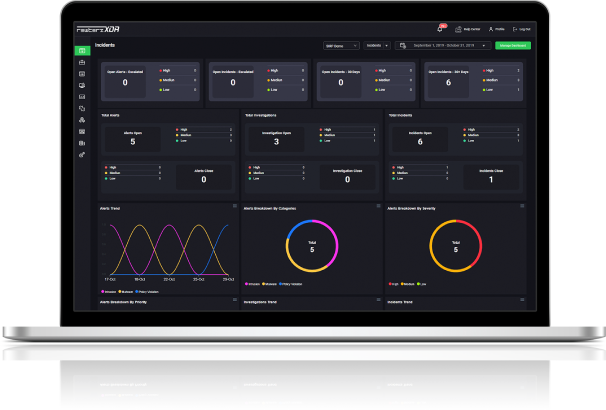

Rewterz Threat Alert – Sodinokibi Ransomware – Active IOCs
September 13, 2021
Rewterz Threat Alert – Donot APT Group – Active IOCs
September 13, 2021
Rewterz Threat Alert – Sodinokibi Ransomware – Active IOCs
September 13, 2021
Rewterz Threat Alert – Donot APT Group – Active IOCs
September 13, 2021Severity
High
Analysis Summary
LockBit ransomware takes as little as five minutes to deploy the encryption routine on target systems once it lands on the victim network. LockBit attacks leave few traces for forensic analysis as the malware loads into the system memory, with logs and supporting files removed upon execution. In one case, they found that the attack began from a compromised Internet Information Server that launched a remote PowerShell script calling another script embedded in a remote Google Sheets document. This script connects to a command and control server to retrieve and install a PowerShell module for adding a backdoor and establish persistence. To evade monitoring and go unnoticed in the logs, the attacker renamed copies of PowerShell and the binary for running Microsoft HTML Applications (mshta.exe); this prompted Sophos to call this a “PS Rename“ attack. The backdoor is responsible for installing attack modules and executes a VBScript that downloads and executes a second backdoor on systems restart.
VPN-related CVEs
- CVE-2019-11510
- CVE-2019-11539
- CVE-2018-13379
- CVE-2019-18935
- CVE-2021-22893
Software Vulnerabilities
- CVE-2019-2725
- CVE-2020-2021
- CVE-2020-5902
- CVE-2018-8453
RDP
- Restrict port access on TCP port 3389
- Apply multi-factor authentication to remote access logins
- Remediate RDP vulnerabilities such as Windows RDP
- CVE-2019-0708 (BlueKeep)
- CVE-2020-3427
- CVE-2020-0610
- CVE-2020-0609
Impact
- Security Bypass
- Information Theft
- Files Encryption
Indicators of Compromise
MD5
- 96de05212b30ec85d4cf03386c1b84af
- 6fc418ce9b5306b4fd97f815cc9830e5
- cdf1d218404415be9668a6a5d44d5589
- b7f1120bcff47ab77e74e387805feabe
- 9dccc012908b030b3fe7c21173442eae
- a2df911d14f4f053ead8675e3ec02550
- ddf549d8266c341ad1c839eb3b74c712
- 94a17386778f0af7bb4cb4ba517622aa
- d9bab1b39a76bb8a30e279c76ea9bd45
- 84866fca8a5ceb187bca8e257e4f875a
- 7c488013e33440f7144624931a530ce0
- 53ec94e3325c7ea427857b0a1e911c66
- d5436df39096935f655022a5ea85066e
- 4d25a9242eac26b2240336fb94d62b1e
- af9ff037caca1f316e7d05db86dbd882
SHA-256
- 00260c390ffab5734208a7199df0e4229a76261c3f5b7264c4515acb8eb9c2f8
- 0545f842ca2eb77bcac0fd17d6d0a8c607d7dbc8669709f3096e5c1828e1c049
- 2ba9fab56458fe832afecf56aae37ff89a8b9a494f3c2570d067d271d3b97045
- 4de287e0b05e138ab942d71d1d4d2ad5fb7d46a336a446f619091bdace4f2d0a
- 743ecc953dcd83a48140c82d8a7dcac1af28e0839aed16628ddfc9454bec8dfa
- 8155c6bea7c1112f022e9c70279df6759679295bd4d733f35b6eea6a97d3598f
- 856d5253f68bebcba161bc8f8393f34c806717faa6297c669c75fb13b17f8d03
- 9bca4fe6069de655467e59929325421b93617bccfdf23e9fba02615d36d60881
- a98ffa66c07f634d19dc014bb2d63fa808d7af5dc9fb9b33aa19a8b944608816
- acad2d9b291b5a9662aa1469f96995dc547a45e391af9c7fa24f5921b0128b2c
- b3faf5d8cbc3c75d4c3897851fdaf8d7a4bd774966b4c25e0e4617546109aed5
- dd8fe3966ab4d2d6215c63b3ac7abf4673d9c19f2d9f35a6bf247922c642ec2d
- ea028ec3efaab9a3ce49379fef714bef0b120661dcbb55fcfab5c4f720598477
- f32e9fb8b1ea73f0a71f3edaebb7f2b242e72d2a4826d6b2744ad3d830671202
- f3e891a2a39dd948cd85e1c8335a83e640d0987dbd48c16001a02f6b7c1733ae
SHA1
- dbe5243c6ea5cc4cfb3edf042bd94a59cf9a0e64
- 95838a8beb04cfe6f1ded5ecbd00bf6cf97cd564
- 1f96fb681907e62b32777b2846962fdf59350ac7
- a185904a46b0cb87d38057fc591a31e6063cdd95
- d6d09f593aba3a7d6db84260e539dc05ac79fb25
- 7a0213eee3358cd7a60554d95e26546fdb038667
- 7c7558fe55062b21572993623f8e6e86530d2de4
- 315816b2ee7c33ccf7718376e446154981d65ad9
- 6e44b060a064cbe485f0128208110b1efd222b56
- 038bc02c0997770a1e764d0203303ef8fcad11fb
- 583186ee5890bcd5b1e4782b475a39acd2e7808b
- 1d88d25ce890b3118bf719fe4d83583868247b86
- 07d28a02c99b65db91e69b3f45c12cff7fe72b4d
- c7b2d4a22f788b1b942f993fff33f233dca960ce
- 844e9b219aaecb26de4994a259f822500fb75ae1
Remediation
- Block the threat indicators at their respective controls.
- Do not respond to emails coming from untrusted sources.
- Do not open untrusted files received by any means.








